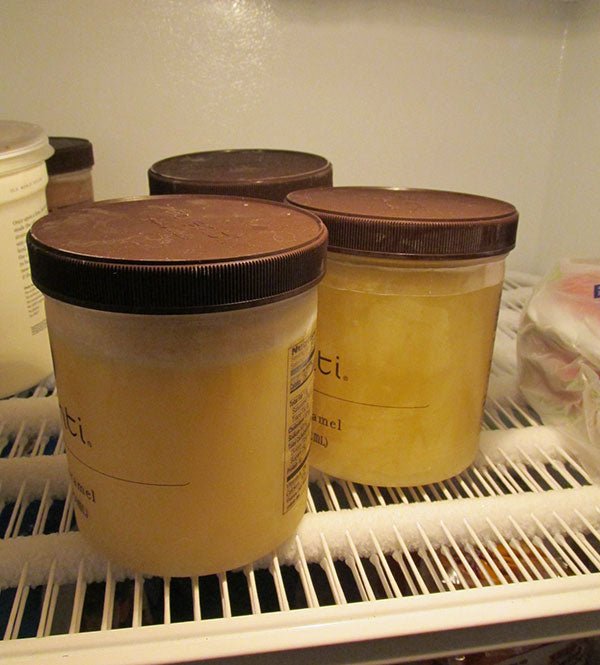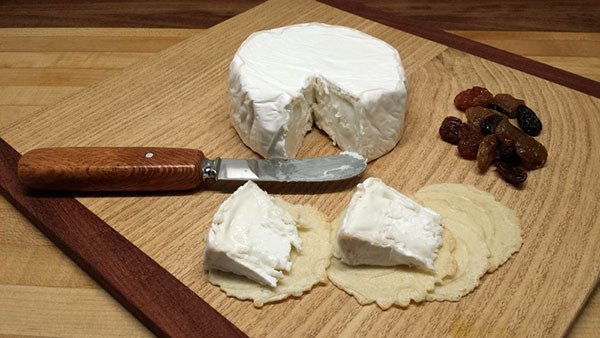
We don’t hear much about freezing milk these days. Home economists used to recommend it, and a lot of farm women used to do it. But, now, we’re more sophisticated and, in general, we try to serve food as fresh as possible.
There’s no question that fresh is best and that applies to milk for cheese making. Ideally, we would use milk within 2 hours of the time it is milked, while it is still warm. Unfortunately, many of us don’t have farms, so we have to drive long distances to buy good milk, whether it’s raw or slow pasteurized and un-homogenized.
I ran into this issue last week when I was going by a farm 25 miles from my home which I knew sold good, raw Jersey milk. I bought the milk, knowing that I wouldn’t have time to make cheese in the next few days. I decided to freeze it.
I realized that I would be compromising the milk, but it seemed like a healthier option than using store-bought, pasteurized, homogenized milk.
I decided to find as much information as I could about freezing milk. I’m hoping you will share your experiences with us in the comments.
How Milk Changes When You Freeze It:
The composition of it changes. Some of the fat globule membranes become damaged, resulting in:
(1) Fat dissolving into the whey which makes it harder to separate the fat globules in order to make cheese. Thus, the yield is less.
(2) The proliferation of short chain fatty acids. (The damaged fat membranes leave the fat globules vulnerable to the lipase enzymes which work to create free fatty acids in the milk.) These acids make it harder for the starter cultures to do their job and they may lead to rancid flavors as the cheese ages.
The second issue doesn’t apply nearly as much in sheep milk because it doesn’t have any where near as much lipase in it as cow and goat milk do. So, when the fat globules are compromised, there isn’t a production of free fatty acids. It’s very common for cheese makers to freeze sheep milk until they have enough to make cheese.
If possible, it’s best to use milk from animals in early lactation. For most farms, this is in the spring. In early lactation, there is the least amount of lipase in the milk. Late lactation milk (often in the fall) has much more lipase in it, so freezing will result in the making of more free fatty acids.
(By the way, all of this information about freezing applies to rough handling of the milk as well. This is why we emphasize treating the milk gently during all phases of cheese making.)
How to Freeze Milk:
If you are starting with fresh, warm milk, you can either pasteurize it immediately or, if you will be using it raw, cool it down to 40F as fast as possible. Some people use ice cream freezers to do this. Or, you can prepare an ice bath. (If you pasteurize, you will still want to cool it down quickly after.) Most of us (at least in our area) have to buy our milk in bottles from the farm where it has already been cooled and refrigerated.
When you are ready to freeze your milk, stir it gently to distribute the fat as evenly as possible.
Pack it into clean, preferably sterilized small bottles, plastic bags or freezer containers – 1 quart containers work well. Always leave room in the container for expansion. (You can use glass, if there is plenty of expansion room.) (Note: If the container has any kind of smell, it will be carried all the way through to the cheese.)
The ideal temperature is -17F/-27C. Be sure the freezer isn’t set to defrost automatically.
Leave your milk in the freezer for as short a period of time as possible – up to 3 months.
When you go to thaw it, keep it in the fridge for 2-3 days.
You will see a greasy layer of fat on top of the milk. This fat will dissolve into the whey and be lost from the cheese. (As mentioned, freezing has consequences!)
How to Make Cheese With Frozen Milk:
You will want to make the fresher cheeses with this milk – chevre, feta, mozzarella, ricotta, cottage cheese, yogurt, kefir, etc. – any cheese that is aged for less than 60 days. That said, if you have sheep milk, from a ewe in early lactation and which you have frozen at a low temperature, you can probably make any aged cheese.
As mentioned above, thaw it out in the fridge before using.
Add calcium chloride to the milk before you add your culture. (Dissolve 1/4 tsp of calcium chloride for every gallon of milk in 1/4 cup cool, non-chlorinated water.)
Follow the directions you would use with milk that hasn’t been frozen. However, note that it may take a little longer to set. So, if you normally add rennet and wait 1/2 hour, you may have to wait a little longer.













































































































































